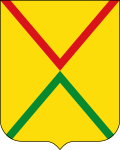Top Qs
Timeline
Chat
Perspective
Arzamas
City in Nizhny Novgorod Oblast, Russia From Wikipedia, the free encyclopedia
Remove ads
Arzamas (Russian: Арзама́с, IPA: [ɐrzɐˈmas] ⓘ) is a city in Nizhny Novgorod Oblast, Russia, located on the Tyosha River (a tributary of the Oka), 410 kilometers (250 mi) east of Moscow. As of 2024, it has a population of 103,629.[10]
Remove ads
History
Summarize
Perspective


Arzamas was founded in 1578,[3] during the reign of Ivan the Terrible, in the lands populated at the time by Mordvins. By 1737, more than 7,000 people lived in Arzamas and the town became a major transit centre on the route from Moscow to eastern parts of Russia. It was known for its geese and onions as well as leather crafts.
Catherine the Great in 1781 granted town status to Arzamas and a coat of arms based on the colours of the Arzamas regiment.[citation needed] In the early 19th century, Arzamas had over twenty churches and cathedrals, the foremost being the Resurrection Cathedral. It was built in the Empire style to commemorate the Russian victory over Napoleon in 1812.
Alexander Stupin art school was located in Arzamas between 1802 and 1862 and many famous Russian artists studied there, including Vasily Perov.
By the early 20th century it was still an important centre of trade, and had tanneries, oil, flour, tallow, dye, soap and iron works; knitting was an important domestic industry, while sheepskins and sail-cloth were articles of trade. The 1897 population was 10,591.[11]
From 1954 to 1957, Arzamas was the center of Arzamas Oblast, a short-lived administrative unit that was split from Gorky Oblast and later merged back into it.
In 1988, the city was the site of the Arzamas train disaster which caused the death of ninety-one people.
Remove ads
Administrative and municipal status
Within the framework of administrative divisions, Arzamas serves as the administrative center of Arzamassky District, even though it is not a part of it.[1] As an administrative division, it is incorporated separately as the city of oblast significance of Arzamas—an administrative unit with the status equal to that of the districts.[2] As a municipal division, the city of oblast significance of Arzamas is incorporated as Arzamas Urban Okrug.[6]
Remove ads
Population
Ethnic composition (2010):[12]
- Russians – 97.9%
- Ukrainians – 0.4%
- Others – 1.7%
Economy

Local industry includes Arzamas Machine-Building Plant, a manufacturer of military and specialized civilian automotive vehicles (such as BTR-80, GAZ Tigr). It is now part of the GAZ holding company. Also in Arzamaz there is the Peshelansky gypsum plant, which has been operating since 1933.[13]
International relations
Twin towns and sister cities
Arzamas is twinned with:
Notable people
- Patriarch Sergius I of Moscow
- Marina Orlova, philologist
- Evgeny Namestnikov, ice hockey player
- Leonid Nikolaev, conductor
- Alexander Stupin, painter
See also
- Arzamas I railway station
- Bayush Razgildeyev
- Sarov (Arzamas-16)
References
External links
Wikiwand - on
Seamless Wikipedia browsing. On steroids.
Remove ads






